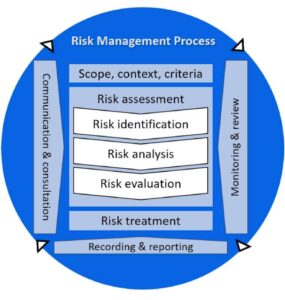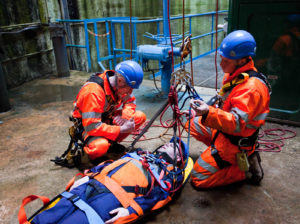What is excavation safety

What is excavation safety? Excavation is a basic part of construction work. It is a dangerous and critical work activity. The term critical depends upon the depth of the excavation, type of the soil and location of the excavation. Excavation has many hazards e.g. collapse, fall of people inside excavation, fall of vehicles, asphyxiation, drowning, biological hazards, gasses, entry-exit limitation, fall of materials inside excavation, etc.
What is Excavation:
A hollow in the ground, created by construction activities, which without effective barriers and warning signs will create a hazard to employees or members of the public.
Guard/ Barrier:
Purpose-built items of equipment which will indicate the presence of an excavation, and in specific instances, prevent a person from falling into an excavation. The general design of such barriers shall be approved by the Safety Officer. All barriers shall be distinctly colored red and white.
Excavation Inspector:
The Excavation Inspector shall be a competent person, designated in writing by the Project Manager, with the duty to perform inspections of all excavations. The inspections shall be recorded in a register, filed and made available to PROJECT MANAGER/RESIDENT ENGINEER. The Excavation Inspector shall be suitably qualified to classify all soils and make recommendations with regard to excavation, shoring and bracing requirements.
PROCEDURE
- Excavation or trenching work shall not be commenced until permission has been obtained and the conditions of all required approval and permitting authorities have been complied with. Notifications to commence work shall be completed and submitted as required. Permits and notifications shall be kept on file and made available to the PROJECT MANAGER/RESIDENT ENGINEER.
- Drawings shall be obtained, if available, showing the location of all underground services and/or utilities. You can also check Excavation safety guide with photos
- All excavations exceeding 1.5 meters in depth shall be adequately protected from collapse by bracing, shoring, sloping sides or other approved methods. Stairs, ramps or ladder access/egress shall be provided at 7.5m centers max. in excavations greater than 1.2m deep.
- All excavations shall be guarded with an approved barrier in accordance with the following recommendations:
a) Excavations not exceeding 2 meters in depth shall be protected by the provision of two continuous bands of high visibility, red and white, warning tape supported at a height of 1 meter and at 50 cm from ground level.
b) Excavations exceeding a depth of 2 meters shall be securely fenced with guardrails/ solid barriers positioned at a height of 1 meter and at 50 cm above ground level. The guardrails shall be constructed to physically prevent a person from falling into the excavation.
3.5 Where it is considered that an excavation creates a risk to employees or members of the public and requires special protection measures e.g Areas of high public movement, specific excavation risks, etc., the Safety Officer should be requested to advise on protection measures required, as follows:
- Excavations shall be sloped to the angle of repose of the material, box trenched or shored, in order to prevent the collapse of sides.
- Excavations, irrespective of depth, which contain water in which it is possible for a person to drown, shall be protected by means of guardrails.
- During the hours of darkness or in areas of poor illumination, excavations shall be provided with high visibility, orange flashing warning lights, fitted to the guarding structure. The warning lights shall be installed at a maximum distance of 3 meters apart and in such positions that are considered adequate to provide a clear warning of the presence of an excavation.
- Excavations shall be clearly sign-posted to warn personnel of the presence of an excavation.
- The use of painted oil drums to form barriers on public highways shall not be permitted. Conventional approved traffic signing equipment, plastic cones, etc., shall be utilized.
- The control of vehicles at road works shall be in accordance with the requirements of the country’s traffic regulations.
- Spoil material shall be kept a minimum of 1.0m away from the excavation edge, and equipment kept a minimum of 1.5m away. Stop blocks shall be positioned to prevent equipment backing into the excavations.
- Where oxygen is deficient (less than 19.5 percent oxygen in the atmosphere). Or a hazardous atmosphere exists or could reasonably be expected to exist, such as in excavations in landfill areas or excavations in areas where hazardous substances are stored nearby. The atmospheres in the excavation shall be tested before employees enter excavations greater than 1.2m in depth






